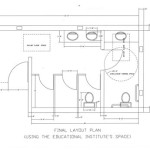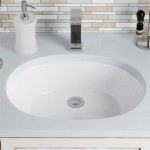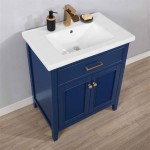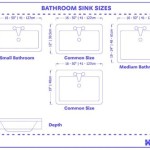Standard Undermount Bathroom Sink Size: A Comprehensive Guide
Selecting the right bathroom sink is a crucial aspect of bathroom design and functionality. Among the various types available, the undermount sink offers a sleek, seamless look and is often favored for its ease of cleaning. Understanding the standard sizes for undermount bathroom sinks is essential for ensuring a proper fit, optimal usability, and aesthetic harmony within the bathroom space. This article provides a detailed overview of standard undermount bathroom sink sizes, discussing factors influencing dimensions, common size ranges, and considerations for installation and compatibility.
The undermount sink derives its name from its installation method, where the sink basin is mounted beneath the countertop, creating a smooth, uninterrupted surface. This contrasts with drop-in or vessel sinks, which sit atop the countertop. The undermount design contributes to a minimalist aesthetic and simplifies countertop cleaning, as debris can be easily wiped directly into the sink. Therefore, the dimensions of an undermount sink are vital to consider, not only for visual appeal but also for practical functionality and compatibility with plumbing and counter space.
Several dimensions are relevant when discussing the size of an undermount bathroom sink. These include: overall width, overall depth (also referred to as front-to-back measurement), bowl depth, and the drain opening. The width and depth determine the overall footprint of the sink, indicating how much counter space it occupies. The bowl depth determines the internal capacity of the sink and influences its usability for various tasks. The drain opening is standardized to fit standard plumbing connections.
Key Considerations for Undermount Sink Dimensions
The perceived "standard" size of an undermount bathroom sink can vary based on the bathroom's overall size, the countertop dimensions, and intended use. However, a few dimensions are quite commonly encountered and can therefore be considered standard benchmarks.
The overall width of an undermount bathroom sink typically ranges from 16 to 24 inches. This horizontal measurement determines how much lateral space the sink will occupy on the countertop. Smaller bathrooms, often found in powder rooms or guest bathrooms, generally benefit from narrower sinks (16-19 inches) to conserve space. Larger master bathrooms can accommodate wider sinks (20-24 inches) that provide more surface area for washing and other tasks.
The overall depth or front-to-back measurement of an undermount bathroom sink usually falls between 12 and 20 inches. Similar to the width, the depth influences the amount of countertop space utilized. A shallower sink (12-16 inches) is suitable for narrow countertops or smaller bathrooms, while a deeper sink (17-20 inches) offers greater capacity but requires more counter depth.
Bowl depth, which is the vertical measurement from the top edge of the sink basin to the bottom, commonly ranges from 5 to 8 inches. This dimension directly impacts the sink's capacity and its suitability for various activities. A shallower bowl (5-6 inches) may be sufficient for handwashing and light use, whereas a deeper bowl (7-8 inches) is advantageous for tasks involving larger volumes of water or items.
Beyond these standard dimensions, oval, rectangular, and square undermount sinks exist, each with slightly varying but overall comparable size ranges. Speciality sizes are also an option but are not as commonly stocked, and may incur customisation costs.
Factors Influencing Undermount Sink Size Selection
Several factors play a crucial role in determining the appropriate size of an undermount bathroom sink. These include the bathroom's overall size, the dimensions of the countertop, the intended use of the sink, and personal preferences.
The size of the bathroom is a primary consideration. In smaller bathrooms or powder rooms, space is at a premium, necessitating smaller, more compact sinks. Choosing a sink that is too large can overwhelm the space and compromise functionality. Conversely, in larger bathrooms, a larger sink can provide a more luxurious and practical experience without feeling cramped.
Countertop dimensions are equally important. The length and depth of the countertop dictate the maximum size of the sink that can be accommodated. It is essential to ensure that there is sufficient countertop space around the sink for comfortable use and to prevent overcrowding. The countertop material and its weight-bearing capacity also must be considered, especially when choosing heavier sink materials such as cast iron.
The intended use of the sink is another key factor. A sink primarily used for occasional handwashing may not require the same depth or width as a sink used for more frequent and varied tasks, such as shaving or washing delicate items. Considering the typical activities that will take place at the sink helps determine the optimal bowl depth and overall size.
Personal preferences also play a role. Some individuals prefer a minimalist aesthetic with a smaller sink, while others prioritize functionality and prefer a larger sink with ample space. The choice of sink shape (round, square, rectangular, oval) can also influence the perceived size and aesthetic appeal of the sink.
Installation Considerations for Undermount Sinks
Proper installation is essential for ensuring the functionality and longevity of an undermount bathroom sink. Several considerations must be taken into account during the installation process, including countertop preparation, sink mounting, and plumbing connections.
Countertop preparation is a critical step. Because the sink is mounted beneath the countertop, a precise cutout must be made to accommodate the sink's dimensions. This cutout should be performed by a professional using appropriate tools to prevent damage to the countertop material. The edges of the cutout must be smooth and properly sealed to prevent water damage and maintain structural integrity.
Sink mounting involves securely attaching the sink to the underside of the countertop. This is typically achieved using mounting clips or epoxy adhesive. The mounting hardware must be robust enough to support the weight of the sink, especially when filled with water. The sink should be level and properly aligned to ensure proper drainage and prevent leaks.
Plumbing connections must be made carefully to ensure a watertight seal. The drain assembly should be properly tightened and sealed with plumbers putty or silicone sealant. The water supply lines must be connected securely to the faucet, and any leaks should be addressed immediately. It is recommended to hire a licensed plumber to handle the plumbing connections to ensure compliance with local codes and regulations.
Compatibility with the chosen faucet is also crucial. The faucet's spout height and reach should be appropriate for the sink's depth and dimensions. A faucet with a spout that is too short may result in water splashing outside the sink, while a faucet with a spout that is too long may obstruct access to the sink basin. Careful consideration should be given to the faucet's design and functionality to ensure a harmonious and practical combination with the undermount sink.
Accessibility considerations are also relevant, especially in bathrooms designed for individuals with mobility issues. The height of the countertop and the depth of the sink should be chosen to facilitate comfortable use for all users. Undermount sinks with shallower bowls can be more accessible for individuals who use wheelchairs or have limited reach.
In conclusion, understanding standard undermount bathroom sink sizes and the factors influencing their selection is crucial for achieving a functional, aesthetically pleasing, and user-friendly bathroom design. By carefully considering the bathroom's size, countertop dimensions, intended use, and installation requirements, it is possible to choose an undermount sink that perfectly complements the space and enhances the overall bathroom experience.

Ruvati 16 In X 11 Undermount Bathroom Sink Brushed Stainless Steel Rvh6107 The Home Depot

Horow 21 5 8 In Rectangular Glazed Ceramic Undermount Bathroom Vanity Sink White With Overflow Drain Hr S5540d The Home Depot

Kingston Brass Piazza Lb21158 21 Inch Ceramic Undermount Bathroom Sink White Default Title

Lordear 18 In Undermount Ceramic Bathroom Vessel Sink White Huf1812 The Home Depot

Magic Home 18 In Undermount Ceramic Rectangle Bathroom Sink White New Sl Luf1814 The Depot

Horow 23 5 8 In Rectangular Glazed Ceramic Undermount Bathroom Vanity Sink White With Overflow Drain Hr S6040d The Home Depot

American Standard Esteem White Undermount Rectangular Traditional Bathroom Sink 19 75 In X 13 The Sinks Department At Com

Allen Roth White Undermount Rectangular Traditional Bathroom Sink 19 69 In X 15 75 The Sinks Department At Com

Us 1812 Dakota Kitchen Sinks Faucets Vanities Tubs Toilets Accessories

Wells Rhythm Series 21 In Rectangular Undermount Single Bowl Bathroom Sink Bisque Rtu2115 7b The Home Depot
Related Posts







